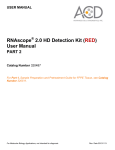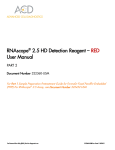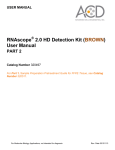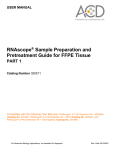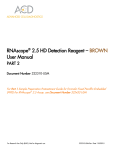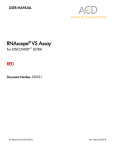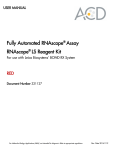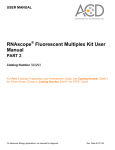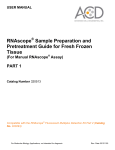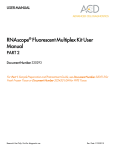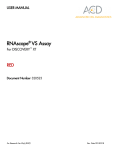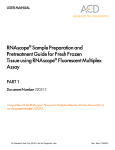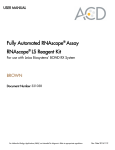Download RNAscope 2-Plex Detection Kit (Chromogenic) User Manual
Transcript
USER MANUAL RNAscope® 2-Plex Detection Kit (Chromogenic) User Manual PART 2 Catalog Number 320494 For Part 1 Sample Preparation Pretreatment Guide for Formalin-Fixed ParaffinEmbedded (FFPE), see Catalog Number 320511. For Molecular Biology Applications, not intended for diagnosis. Rev. Date 20131220 For Molecular Biology Applications, not intended for diagnosis. Trademarks ® ™ RNAscope and HybEZ are trademarks of Advanced Cell Diagnostics, Inc. All other trademarks belong to their respective owners. ® Citing RNAscope 2.0 in Publications ® When describing a procedure for publication using this product, please refer to it as the RNAscope 2.0 Assay and ® cite: Wang F, Flanagan J, Su N, Wang L-C, Bui S, Nielson A, Wu X, Vo H-T, Ma X-J and Luo Y. RNAscope : A Novel In Situ RNA Analysis Platform for Formalin-Fixed Paraffin-Embedded Tissues. J. Mol. Diagnostics, 2012, 14:22–29. Disclaimers Advanced Cell Diagnostics, Inc. reserves the right to change its products and services at any time to incorporate technological developments. This manual is subject to change without notice. Although this manual has been prepared with every precaution to ensure accuracy, Advanced Cell Diagnostics, Inc. assumes no liability for any errors, omissions, or for any damages resulting from the use of this information. Copyright © 2013, Advanced Cell Diagnostics, Inc. All rights reserved. Contents Chapter 1. Product Information .......................................................5 About this guide ............................................................................................... 5 Product description .......................................................................................... 5 Background ............................................................................................... 5 Overview ................................................................................................... 5 Kit contents and storage .................................................................................. 6 ® RNAscope Probes ................................................................................... 6 ® RNAscope 2-Plex Detection Kit (Chromogenic) ..................................... 7 Required materials and equipment ................................................................. 8 ™ HybEZ Hybridization System .................................................................. 8 User-supplied materials ............................................................................ 9 Chapter 2. Before You Begin .........................................................11 Important procedural guidelines .................................................................... 11 Chapter 3. RNAscope® 2.0 Assay ..................................................13 Workflow ........................................................................................................ 13 Materials required for the assay .................................................................... 14 Prepare the materials .................................................................................... 14 Prepare 1X Wash Buffer ......................................................................... 14 Prepare probes ....................................................................................... 15 Prepare counterstaining reagents ........................................................... 15 Prepare mounting reagents .................................................................... 15 Equilibrate reagents ................................................................................ 15 Run the assay................................................................................................ 15 Hybridize probe ....................................................................................... 15 Hybridize Amp 1 ...................................................................................... 16 Hybridize Amp 2 ...................................................................................... 16 Hybridize Amp 3 ...................................................................................... 17 Hybridize Amp 4 ...................................................................................... 17 Hybridize Amp 5 ...................................................................................... 17 Hybridize Amp 6 ...................................................................................... 18 Detect the red signal ............................................................................... 18 Detect the green signal ........................................................................... 18 Counterstain the slides ........................................................................... 19 Mount the samples .................................................................................. 19 Evaluate the samples .................................................................................... 19 Scoring guidelines ................................................................................... 20 Quantitative Image Analysis ................................................................... 20 Control examples .................................................................................... 20 Troubleshooting ............................................................................................. 20 Appendix A. Tissue Pretreatment Recommendation ................... 21 Tissue pretreatment recommendation........................................................... 21 ® RNAscope 2-Plex Detection Kit (Chromogenic) User Manual 3 Tissue-specific pretreatment conditions ................................................. 21 Appendix B. Reagent Volume Guidelines ..................................... 23 Determine reagent volume ............................................................................ 23 Appendix C. Safety .........................................................................25 Chemical safety ............................................................................................. 25 Biological hazard safety................................................................................. 25 Documentation and support ..........................................................27 Obtaining MSDSs .......................................................................................... 27 Obtaining support .......................................................................................... 27 Contact information ....................................................................................... 27 Limited product warranty ............................................................................... 27 4 ® RNAscope 2-Plex Detection Kit (Chromogenic) User Manual Chapter 1. Product Information 1 Before using this product, read and understand the information in Appendix C. Safety on page 25. IMPORTANT! protocols. We recommend reading the entire user manual before beginning any About this guide This user manual provides guidelines and protocols to use the RNAscope® 2-Plex Detection Kit – Chromogenic (Cat. No. 310035). RNAscope® Assays are compatible with a variety of sample types. You must use both an RNAscope® Detection kit user manual and a sample preparation and pretreatment user guide to perform the entire assay. IMPORTANT! For Part 1, Sample Preparation and Pretreatment Guide for FFPE Tissue, see Catalog No. 320511. Visit www.acdbio.com/support/technical-doc to download a sample preparation user guide. Product description Background The RNAscope® 2-Plex Chromogenic Assay uses a novel and proprietary method of in situ hybridization (ISH) to simultaneously visualize two RNA targets in samples mounted on slides. The assay is based on ACD’s patented signal amplification and background suppression technology and incorporates multiplexed signal amplification systems, which enable users to investigate expression as well as positional relationship between two different genes within a cellular context. Overview The RNAscope® 2-Plex Chromogenic Assay procedure is illustrated in Figure 1 on page Error! Bookmark not defined.. The procedure can be completed in 8–10 hours or conveniently divided over two days. Most of the RNAscope® Assay reagents are available in convenient Ready-To-Use (RTU) dropper bottles and provide a simple, nearly pipette-free workflow. Starting with properly prepared samples, sections are first pretreated, and then RNA-specific probes are hybridized to target RNA. The RNAscope® 2-Plex Chromogenic Assay employs two independent signal amplification systems, each using a different chromogenic enzyme. Single RNA transcripts for two target genes appear as punctate dots of two distinctly colored chromogen precipitates, visible using a common bright-field microscope at 40–100X magnification. ® RNAscope 2-Plex Detection Kit (Chromogenic) User Manual 5 1: Tissue section 2:Hybridize to target RNA Start with properly prepared tissue sections and pretreat to allow access to target RNA. Hybridize two sets of gene-specific probe pairs to target mRNA. 3: Amplify signal Use two independent signal amplification systems to detect both target RNAs. Probes are hybridized to a cascade of signal amplification molecules, culminating in binding of HRP- or AP-labeled probes. Add two chromogenic substrates to detect RNAs. 4: Image Visualize target RNA using a standard bright-field microscope. Figure 1 Procedure overview Kit contents and storage The RNAscope® 2-Plex Assay requires the RNAscope® Probes and the RNAscope® 2-Plex Detection Kit (Chromogenic), which are available separately. RNAscope® Probes The RNAscope® Probes consist of user-specified Target Probes and Positive and Negative Control Probes. Each Target Probe contains a mixture of short oligonucleotides designed to bind to a specific target RNA and detectable in one of two color channels, C1 or C2. Note: Different colors are assigned to the C1 and C2 color channels depending on the particular RNAscope® Assay. The color channels for the RNAscope® 2-Plex Detection Kit (Chromogenic) Assay are shown in the following table: Probe Chromogenic Labels Channel ID Enzyme Color C1* HRP GREEN C2 AP RED * Default channel Channel C1 target probes are Ready-To-Use (RTU), while channel C2 probes are shipped as a 50X concentrated stock. To independently detect two target RNAs in a 2-Plex assay, each target probe must be in a different color channel and there must be a C1 probe in the mixture. A “Blank Probe – C1” (Cat. No. 300041) can be used in place of a specific target probe. 6 ® RNAscope 2-Plex Detection Kit (Chromogenic) User Manual Each probe is sufficient for staining ~20 sections, each with an area of approximately 20 mm x 20 mm (0.75” x 0.75”). Larger tissue sections will result in fewer tests. The probes have a shelf life of six months from the shipment date when stored as indicated in the following table: Target Probes Reagent Cat. No. Content Quantity Storage ® Various Ready-To-Use (RTU) probe for color channel 1 3 mL x 1 bottle 4°C ® Various 50X probe for color channel 2 60 μL x 1 tube 4°C RNAscope Kit — 2-Plex Target Probe – [species] – [gene]* RNAscope Kit — 2-Plex Target Probe – [species] – [gene] – C2 Control Probes Reagent Cat. No. Content Quantity Storage ® Various RTU probe targeting a common housekeeping gene. Each detection channel has its own positive control probe. 3 mL x 1 bottle 4°C ® Various RTU mixture of two probes targeting POLR2A in channel C1 and PPIB in channel C2. 3 mL x 1 bottle 4°C RNAscope Kit — Negative Control Probe – dapB ® 310043 RTU probe targeting a bacterial gene. Each detection channel has its own negative control probe. 3 mL x 1 bottle 4°C Blank Probe-C1 300041 RTU Target Probe diluent 3 mL x 1 bottle 4°C RNAscope Kit — Positive Control Probe RNAscope Kit — 2-Plex Positive Control Probe * No “C1” in label. RNAscope® 2-Plex Detection Kit (Chromogenic) Each RNAscope® 2-Plex Detection Kit – Chromogenic (Cat. No. 310035) provides enough reagents to stain ~20 tissue sections, each with an area of approximately 20 mm x 20 mm (0.75” x 0.75”). Larger tissue sections will result in fewer tests. Each kit contains three sub-kits: a Pretreatment Kit, a Detection Kit, and a Wash Buffer Kit. IMPORTANT! Directions to use the Pretreatment Kit are included in separate sample preparation and pretreatment user guides. The reagents have a shelf life of six months from the shipment date when stored as indicated in the following table: Pretreatment Kit (Cat. No. 310020) Reagent Quantity Storage 1X Pretreat 1 — endogenous enzyme blocker 4 mL x 2 bottles 4°C 10X Pretreat 2* 70 mL x 4 bottles Room temperature (20–25°C) 4.5 mL x 1 bottle 4°C † 1X Pretreat 3 — protease 2-Plex Detection Kit (Cat. No. 320701)** Reagent Quantity Storage 2-Plex Amp 1 3 mL x 1 bottle 4°C 2-Plex Amp 2 4.5 mL x 1 bottle 4°C 2-Plex Amp 3 3 mL x 1 bottle 4°C ® RNAscope 2-Plex Detection Kit (Chromogenic) User Manual 7 2-Plex Amp 4A 4.5 mL x 1 bottle 4°C 2-Plex Amp 4B 30 μL x 1 tube 4°C 2-Plex Amp 5 4.5 mL x 1 bottle 4°C 2-Plex Amp 6 3 mL x 1 bottle 4°C Red-A — Fast Red diluent 3 mL x 1 bottle 4°C Red-B — Fast Red substrate 50 μL x 1 tube 4°C Green-A — Green diluent 3 mL x 1 bottle 4°C Green-B — Green substrate 150 µL x 1 vial 4°C Wash Buffer Kit (Cat. No. 310091) Reagent Quantity 50X Wash Buffer 60 mL x 4 bottles Storage Room temperature (20–25°C) * Comes in a separate box. † Comes in two boxes. IMPORTANT! RNAscope® Detection Kits share the same Pretreatment Kit and Wash Buffer, but have unique Detection Kits. Do not interchange the reagent components of the Detection Kits, even those having the same name. Required materials and equipment The following materials and equipment are needed to perform the RNAscope® Assay. HybEZ™ Hybridization System IMPORTANT! The RNAscope® Assay has been validated using this system only. The HybEZ™ Hybridization System (110 VAC, Cat. No. 310010; 220 VAC, Cat. No. 310013) is designed for the hybridization and incubation steps in the RNAscope® Assays. Incubation steps in the RNAscope® Assay require humid conditions to prevent sections from drying out. For instructions on how to use the HybEZ™ Hybridization System, refer to the HybEZ™ Hybridization System User Manual available at www.acdbio.com/support/technical-doc and view the training video at www.acdbio.com/support/online-training-videos. The system contains the following components: Component Cat. No. ™ 1 oven 310010 or 310013 ™ 1 tray 310012 ™ 1 rack 310014 ™ 2 sheets — ™ 15 sheets 310015 HybEZ Oven (110 or 220 VAC) HybEZ Humidity Control Tray (with lid) HybEZ Slide Rack (20 slide capacity) HybEZ Humidifying Paper HybEZ Humidifying Paper Pack 8 Quantity ® RNAscope 2-Plex Detection Kit (Chromogenic) User Manual User-supplied materials IMPORTANT! table. Do not substitute other materials for the EcoMount listed in the following Description Supplier Cat. No. EcoMount (required) Biocare 100% ethanol (EtOH) American Master Tech Scientific/MLS ALREAGAL Gill’s Hematoxylin I American Master Tech Scientific/MLS HXGHE1LT Xylene Fisher Scientific/MLS X3P-1GAL ® American Master Tech Scientific/MLS LWSRA24 ® American Master Tech Scientific/MLS LWT4457EA Tissue-Tek Clearing Agent Dish, xylene resistant (1 required) ® American Master Tech Scientific/MLS Cover Glass 24 x 50 mm Fisher Scientific/MLS 12--545-F Ammonium hydroxide, 28–30% Sigma-Aldrich/MLS 320145-500mL Carboy (>3L) MLS — Water bath or incubator, capable of holding temperature at 40 +/- 1°C MLS — Pipettors and tips, 1–1000 µL MLS — Distilled water MLS — Tubes (various sizes) MLS — Fume hood MLS — Graduated cylinder MLS — Parafilm MLS — Paper towel or absorbent paper MLS — Microcentrifuge MLS — Microscope and accessories MLS — Drying oven, capable of holding temperature at 60 +/- 1°C MLS — Tissue-Tek Vertical 24 Slide Rack Tissue-Tek Staining Dish (3 required) EM897L * LWT4456EA * Major Laboratory Supplier in North America. For other regions, please check Catalog Numbers with your local lab supplier. ® RNAscope 2-Plex Detection Kit (Chromogenic) User Manual 9 10 ® RNAscope 2-Plex Detection Kit (Chromogenic) User Manual Chapter 2. Before You Begin 2 IMPORTANT! For Part 1, Sample Preparation and Pretreatment Guide for FFPE Tissue, see Catalog No. 320511. Prior to running the RNAscope® Assay on your samples for the first time, we recommend that you: • View the video demonstrations available at www.acdbio.com/support/online-trainingvideos. • Run the assay on FFPE RNAscope® Control Slides (Cat. No. 310045) using the Positive and Negative Control Probes. Important procedural guidelines • Start with properly fixed and prepared sections. Refer to Appendix A. Tissue Pretreatment Recommendation on page 21 and to our sample preparation and pretreatment user guides available at www.acdbio.com/support/technical-doc. • Use only samples mounted on SuperFrost Plus® Slides (Fisher Scientific; Cat. No. 12-550-15). • Follow the recommended pretreatment conditions for your sample. Refer to our sample preparation and pretreatment user guides available at www.acdbio.com/support/technical-doc. • Always run positive and negative control probes on your sample to assess sample RNA quality and optimal permeabilization. • Do not substitute required materials. Assay has been validated with these materials only. • Follow the protocol exactly for best results. • Do not let your sections dry out during the procedure. • Use good laboratory practices and follow all necessary safety procedures. Refer to Appendix C. Safety on page 25 for more information. ® RNAscope 2-Plex Detection Kit (Chromogenic) User Manual 11 12 ® RNAscope 2-Plex Detection Kit (Chromogenic) User Manual Chapter 3. RNAscope® 2.0 Assay 3 IMPORTANT! For Part 1, Sample Preparation and Pretreatment Guide for FFPE Tissue, see Catalog No. 320511. This procedure flows directly from sample preparation and pretreatment. Refer to the appropriate sample preparation and pretreatment user guide for your specific sample type. Workflow Prepare the materials ~30 MIN Run the assay ~5.5 HRS Hybridize probe ~2 HRS Hybridize Amp 1 ~30 MIN Hybridize Amp 2 ~15 MIN Hybridize Amp 3 ~30 MIN Hybridize Amp 4 ~15 MIN Hybridize Amp 5 ~30 MIN Hybridize Amp 6 ~15 MIN Detect the signal ~40 MIN Counterstain the slides ~2 MIN Bake Slides ~15 MIN Mount samples ~5 MIN Review results ® RNAscope 2-Plex Detection Kit (Chromogenic) User Manual 13 Materials required for the assay Materials provided by the RNAscope 2-Plex Detection Kit (Chromogenic) ® Materials provided by ® RNAscope Probes Other materials and equipment • 50X Wash Buffer • C1 Target Probe • Prepared sections • 2-Plex Amp 1 • 50X C2 Target Probe • Distilled water • 2-Plex Amp 2 • 2-Plex Positive Control Probe • Carboy (>3L) • 2-Plex Amp 3 • Negative Control Probe • Fume hood • 2-Plex Amp 4A • Xylene • 2-Plex Amp 4B • 100% ethanol • 2-Plex Amp 5 • Tissue-Tek Staining Dish (3) • 2-Plex Amp 6 • Tissue-Tek Clearing Agent Dish, xylene-resistant (1) ® ® • Red-A • Gill’s Hematoxylin I • Red-B • Ammonium hydroxide, 28–30% • Green-A • Graduated cylinder • Green-B • Parafilm • HybEZ Humidifying System ™ • Water bath or incubator • Tissue-Tek Vertical 24 Slide Rack ® • Tubes (various sizes) • Paper towel or absorbent paper • Pipettors and tips, 1–1000 µL • Microcentrifuge • Dry oven • EcoMount • Cover Glass, 24 mm x 50 mm Prepare the materials You may prepare the reagents at the same time you prepare pretreatment reagents. Refer to a sample preparation and pretreatment user guide available at www.acdbio.com/support/technical-doc. Some of the materials may be prepared in advance and stored at room temperature. Prepare 1X Wash Buffer • Prepare 3 L of 1X WASH BUFFER by adding 2.94 L distilled water to 1 bottle (60 mL) in a large carboy. Mix well. Note: If precipitation occurs in 50X Wash Buffer, warm it up at 40°C for 10–20 min before making 1X Wash Buffer. 1X Wash Buffer may be prepared ahead of time and stored at room temperature for up to one month. 14 ® RNAscope 2-Plex Detection Kit (Chromogenic) User Manual Prepare probes 1. Warm probes for 10 MIN at 40°C in a water bath or incubator, then cool to ROOM TEMPERATURE (RT). 2. Briefly spin the C2 probe to collect the liquid at the bottom of the tubes. 3. Mix 1:50 ratio of C2 probe to C1 probe by pipetting 1 volume of C2 probe to 50 volumes of C1 probe into a tube. Invert the tube several times. Note: Do not mix probes of the same color. The mixed Target Probes can be stored at 4°C for up to 6 MONTHS Prepare counterstaining reagents • In the fume hood, prepare 50% HEMATOXYLIN staining solution by adding 100 mL Gill’s Hematoxylin I to 100 mL distilled water in a Staining Dish. Note: 50% Hematoxylin staining solution can be reused for up to 1 week. • In the fume hood, prepare 0.02% (w/v) AMMONIA WATER (bluing reagent) by adding 1.43 mL of 1N ammonium hydroxide to 250 mL distilled water in a graduated cylinder or other container. • Seal the cylinder with parafilm. Mix well 3–5 TIMES. Note: For assay quantitation, it is critical to use Ammonium Hydroxide. Prepare mounting reagents IMPORTANT! the assay. Do not reuse deparaffinization reagents for dehydration of the slides after • In the fume hood, add ~200 mL XYLENE to a Clearing Agent Dish. Note: Reagents may be prepared ahead of time. Ensure all containers remain covered. Equilibrate reagents • Place AMP 1–6 reagents at RT. • Ensure HybEZ™ OVEN and prepared Humidity Control TRAY are at 40°C. Run the assay IMPORTANT! Do NOT let sections dry out between incubation steps. Work quickly and fill barrier with solutions. IMPORTANT! View the wash step video at www.acdbio.com/support/online-trainingvideos/wash-slides before proceeding. Note: We recommend running controls before running any of your samples to optimize the protocol. Hybridize probe IMPORTANT! Prior to this step, ensure you have pretreated your samples. See Catalog No. 320511 for FFPE Tissue. ® RNAscope 2-Plex Detection Kit (Chromogenic) User Manual 15 IMPORTANT! Ensure probes are prewarmed to dissolve any precipitation prior to use. 1. Tap and/or flick to remove excess liquid from slides and place in the HybEZ™ Slide Rack. Add ~4 DROPS of the appropriate PROBE to entirely cover each section. Note: Refer to Appendix B. Reagent Volume Guidelines on page Error! Bookmark not defined. to determine the recommended number of drops needed per slide. For example, for a 0.75” x 0.75” barrier add 4 drops of the appropriate probe. 2. Place the HybEZ™ Slide Rack in the HybEZ™ Humidity Control Tray removed from the HybEZ™ Oven. Close tray and insert back into the oven for 2 HRS at 40°C. IMPORTANT! position. To prevent evaporation, make sure the turn nob is completely turned to lock 3. Remove the HybEZ™ Control Tray from the oven and remove HybEZ™ Slide Rack. 4. One slide at a time, quickly remove excess liquid and place slide in a Tissue-Tek® Slide Rack submerged in the Tissue-Tek® Staining Dish filled with 1X WASH BUFFER. 5. Wash slides in 1X Wash Buffer for 2 MIN at RT. Agitate slides by moving the Slide Rack up and down in the dish. 6. Repeat Step 5 with fresh 1X Wash Buffer. Hybridize Amp 1 1. Take each slide one at a time from the Tissue-Tek® Slide Rack and tap/and or flick to remove the excess liquid before placing in the HybEZ™ Slide Rack. Add ~4 DROPS of AMP 1 to entirely cover each section. 2. Place the HybEZ™ Slide Rack in the HybEZ™ Humidity Control Tray. Close tray and insert into the oven for 30 MIN at 40°C. 3. Remove the HybEZ™ Control Tray from the oven and remove HybEZ™ Slide Rack. 4. One slide at a time, quickly remove excess liquid and place slide in a Tissue-Tek® Slide Rack submerged in the Tissue-Tek® Staining Dish filled with 1X WASH BUFFER. 5. Wash slides in 1X Wash Buffer for 2 MIN at RT with occasional agitation. 6. Repeat Step 5 with fresh 1X Wash Buffer. Hybridize Amp 2 1. Take each slide one at a time from the Tissue-Tek® Slide Rack and tap and/or flick to remove the excess liquid before placing in the HybEZ™ Slide Rack. Add ~4 DROPS of AMP 2 to entirely cover each section. 2. Place the HybEZ™ Slide Rack in the HybEZ™ Humidity Control Tray. Close tray and insert into the oven for 15 MIN at 40°C. 3. Remove the HybEZ™ Control Tray from the oven and remove HybEZ™ Slide Rack. 4. One slide at a time, quickly remove excess liquid and place slide in a Tissue-Tek® Slide Rack submerged in the Tissue-Tek® Staining Dish filled with 1X WASH BUFFER. 5. Wash slides in 1X Wash Buffer for 2 MIN at RT with occasional agitation. 6. Repeat Step 5 with fresh 1X Wash Buffer. 16 ® RNAscope 2-Plex Detection Kit (Chromogenic) User Manual Hybridize Amp 3 1. Take each slide one at a time from the Tissue-Tek® Slide Rack and tap/and or flick to remove the excess liquid before placing in the HybEZ™ Slide Rack. Add ~4 DROPS of AMP 3 to entirely cover each section. 2. Place the HybEZ™ Slide Rack in the HybEZ™ Humidity Control Tray. Close tray and insert into the oven for 30 MIN at 40°C. 3. Remove the HybEZ™ Control Tray from the oven and remove HybEZ™ Slide Rack. 4. One slide at a time, remove excess liquid and place slide in a Tissue-Tek® Slide Rack submerged in the Tissue-Tek® Staining Dish filled with 1X WASH BUFFER. 5. Wash slides in 1X Wash Buffer for 2 MIN at RT with occasional agitation. 6. Repeat Step 5 with fresh 1X Wash Buffer. Hybridize Amp 4 1. Briefly spin down the contents of AMP 4B to be sure content is at the bottom of the tube before opening cap. 2. Depending on the size of your hydrophobic barrier, make AMP4 WORKING SOLUTION per section by using a 1:50 ratio of Amp 4B to Amp 4A. For example, for a 0.75” x 0.75” barrier, add 2.4 μL of AMP 4B to 120 μL of AMP 4A into a tube. Mix well. 3. Take each slide one at a time from the Tissue-Tek® Slide Rack and tap/and or flick to remove the excess liquid before placing in the HybEZ™ Slide Rack. 4. Pipette ~120 μL of AMP 4 onto each section. Ensure sections are covered. 5. Place the HybEZ™ Slide Rack in the HybEZ™ Humidity Control Tray. Close tray and insert into the oven for 15 MIN at 40°C. 6. Remove the HybEZ™ Control Tray from the oven and remove HybEZ™ Slide Rack. IMPORTANT! Do not insert tray into the HybEZ™ Oven for the rest of the procedure. 7. One slide at a time, remove excess liquid and place slide in a Tissue-Tek® Slide Rack submerged in the Tissue-Tek® Staining Dish filled with 1X WASH BUFFER. 8. Wash slides in 1X Wash Buffer for 2 MIN at RT with occasional agitation. 9. Repeat Step 8 with fresh 1X Wash Buffer. Hybridize Amp 5 1. Take each slide one at a time from the Tissue-Tek® Slide Rack and tap/and or flick to remove the excess liquid before placing in the HybEZ™ Slide Rack. Add ~4 DROPS of AMP 5 to entirely cover each section. 2. Place the HybEZ™ Slide Rack in the HybEZ™ Humidity Control Tray. Seal tray and incubate for 30 MIN at RT. 3. Remove the HybEZ™ Slide Rack from the HybEZ™ Humidity Control Tray. 4. One slide at a time, quickly remove excess liquid and place slide in a Tissue-Tek® Slide Rack submerged in the Tissue-Tek® Staining Dish filled with 1X WASH BUFFER. 5. Wash slides in 1X Wash Buffer for 2 MIN at RT with occasional agitation. 6. Repeat Step 5 with fresh 1X Wash Buffer. ® RNAscope 2-Plex Detection Kit (Chromogenic) User Manual 17 Hybridize Amp 6 1. Take each slide one at a time from the Tissue-Tek® Slide Rack and tap/and or flick to remove the excess liquid before placing in the HybEZ™ Slide Rack. Add ~4 DROPS of AMP 6 to entirely cover each section. 2. Place the HybEZ™ Slide Rack with the slides in the HybEZ™ Humidity Control Tray. Close tray and incubate for 15 MIN at RT. 3. Remove the HybEZ™ Slide Rack from the HybEZ™ Humidity Control Tray. 4. One slide at a time, remove excess liquid and place slide in a Tissue-Tek® Slide Rack submerged in the Tissue-Tek® Staining Dish filled with 1X WASH BUFFER. 5. Wash slides in 1X Wash Buffer for 2 MIN at RT with occasional agitation. 6. Repeat Step 5 with fresh 1X Wash Buffer. Detect the red signal 1. Briefly spin down the contents of the RED-B tube to be sure content is at the bottom of the tube before opening the cap. 2. Depending on the size of your hydrophobic barrier, make RED WORKING SOLUTION per section by using a 1:60 ratio of Red-B to Red-A. For example, for a 0.75” x 0.75” barrier, add 2 μL of RED-B to 120 μL of RED-A into a tube. Mix well. IMPORTANT! Use the RED solution within 15 MIN. Do not expose to direct sunlight or UV light. 3. Take each slide one at a time from the Tissue-Tek® Slide Rack and tap and/or flick to remove the excess liquid before placing in the HybEZ™ Slide Rack. 4. Pipette ~120 μL RED solution onto each tissue section. Ensure sections are covered. 5. Place the HybEZ™ Slide Rack with the slides in the HybEZ™ Humidity Control Tray. Seal tray and incubate for 30 MIN at RT. 6. Remove the HybEZ™ Slide Rack from the HybEZ™ Humidity Control Tray. 7. To remove the RED solution from the slides, tilt each slide one at a time over a waste container and tap the corner on the edge of the container. Immediately insert the slide into a Tissue-Tek® Slide Rack submerged in a Tissue-Tek® Staining Dish filled with 1X WASH BUFFER. 8. Wash slides in 1X Wash Buffer for 2 MIN at RT with occasional agitation. 9. Repeat Step 8 with fresh 1X Wash Buffer. Detect the green signal 1. Briefly spin down the contents of the GREEN-B tube to be sure content is at the bottom of the tube before opening the cap. 2. Depending on the size of your hydrophobic barrier, make GREEN WORKING SOLUTION per section by using a 1:50 ratio of Green-B to Green-A. For example, for a 0.75” x 0.75” barrier, add 2.4 μL of GREEN-B to 120 μL of GREEN-A into a tube. Mix well. IMPORTANT! Use the GREEN solution within 15 MIN. Do not expose to direct sunlight or UV light. 18 ® RNAscope 2-Plex Detection Kit (Chromogenic) User Manual 3. Take each slide one at a time from the Tissue-Tek® Slide Rack and tap and/or flick to remove the excess liquid before placing in the HybEZ™ Slide Rack. 4. Pipette ~120 μL GREEN solution onto each tissue section. Ensure sections are covered. 5. Place the HybEZ™ Slide Rack with the slides in the HybEZ™ Humidity Control Tray. Seal tray and incubate 10 MIN at RT. 6. Remove the HybEZ™ Slide Rack from the HybEZ™ Humidity Control Tray. 7. To remove the GREEN WORKING SOLUTION from the slides, tilt each slide one at a time over a waste container and tap the corner on the edge of the container. Immediately insert the slide into a Tissue-Tek® Slide Rack submerged in a Tissue-Tek® Staining Dish filled with DISTILLED WATER. Rinse again with fresh distilled water. Counterstain the slides 1. Move the Tissue-Tek® Slide Rack into the Staining Dish containing the 50% HEMATOXYLIN I staining solution for 30 SEC at RT. Slides will be purple. 2. Immediately transfer the Slide Rack back into the Staining Dish containing distilled water, and WASH slides 3–5 TIMES by moving the rack up and down. Keep repeating with fresh distilled water until the slides are clear, while sections remain purple. 3. Replace distilled water in the Staining Dish with 0.02% AMMONIA WATER. Move rack up and down 2–3 TIMES. Section should turn blue. 4. Replace ammonia water with DISTILLED WATER. Wash slides 3–5 TIMES. Mount the samples 1. Remove the Slide Rack from the Staining Dish and dry slides in a 60°C dry oven for 15 MIN. IMPORTANT! The GREEN AND RED SUBSTRATES are alcohol sensitive. Do not dehydrate the slides in alcohol. 2. Briefly dip one slide into fresh pure xylene and immediately place 1–2 DROPS of EcoMount on the slide before the xylene dries. IMPORTANT! Use the EcoMount mounting medium only. 3. Carefully place a 24 mm x 50 mm coverslip over the tissue section. Avoid trapping air bubbles. 4. Repeat steps 2 and 3 for each slide. 5. Air dry slides for 5 MIN. Evaluate the samples Examine tissue sections under a standard bright field microscope at 20–40X magnification: ® • Assess tissue and cell morphology. • Assess positive control signal strength. Positive control signal should be visible as punctuate dots within cell nuclei at 20–40X magnification. • Assess negative control background. One dot to every 10 cells displaying background DAB staining per 20X microscope field is acceptable. RNAscope 2-Plex Detection Kit (Chromogenic) User Manual 19 • Evaluate target probe signal using the scoring guidelines in the next section. Scoring guidelines The RNAscope® Assay can enhance the value of in situ hybridization results by enabling a semi-quantitative scoring guideline utilizing the estimated number of punctate dots present within each cell boundary. An example of how to develop such a guideline for semiquantitative assessment of RNAscope® staining intensity is presented below for a gene with expression level varying between 1 to > 10 copies per cell. If your gene expression level is higher or lower than this range, you may need to scale the criteria accordingly. Categorize staining into five grades: 0, 1+, 2+, 3+ and 4+ according to the following table: Staining score Microscope objective scoring* 0 No staining or less than 1 dot in every ten cells (40X magnification) 1 1–3 dots/cell (visible at 20–40X magnification) 2 4–10 dots/cell. Very few dot clusters (visible at 20–40X magnification) 3 >10 dots/cell. Less than 10% positive cells have dot clusters (visible at 20X magnification) 4 >10 dots/cell. More than 10% positive cells have dot clusters (visible at 20X magnification) * Discount cells with artificially high nuclear background staining. Quantitative Image Analysis RNAscope® Spot Studio Software is designed for pathologists with no prior training in image analysis. This intuitive software allows users to get statistical results with complete information of cell-count/region and number of spots/cell. Simply load any image, select a region of interest, define settings and run analysis, followed by a quality control review before results are exported. Further information is available on our website at www.acdbio.com. Control examples Figure 2 is an example of the detection of PECAM1 and EGFR in lung FFPE tissue at 40 X magnification. ® Figure 2 RNAscope 2-Plex detection of PECAM1 and EGFR mRNA in lung FFPE tissue. Troubleshooting For troubleshooting information, please contact technical support at [email protected]. 20 ® RNAscope 2-Plex Detection Kit (Chromogenic) User Manual Appendix A. Tissue Pretreatment Recommendation A Follow the recommended pretreatment conditions based on your tissue type for: • Any new or previously untested FFPE tissue types • Samples prepared differently than the sample preparation protocol found in Part 1, Sample Preparation and Pretreatment Guide for FFPE Tissue (Cat. No. 320511). Tissue pretreatment recommendation 1. Stain representative samples using the positive and negative control probes. 2. Fix sample in fresh 10% NBF for 16–32 HRS at RT. Note: Perform tissue fixation step using the recommended amount of time. Over or underfixation will result in significant signal loss when performing the RNAscope® Assay. 3. Depending on your tissue type (see section below), vary the PRETREAT 2 and/or PRETREAT 3 TIME. Reagent Mild Standard Extended Pretreat 2 15 MIN 15 MIN 30 MIN Pretreat 3 15 MIN 30 MIN 30 MIN Note: Sample types such as certain Xenografts and Cell Pellets, require less time. For these tissue types, vary the PRETREAT 2 TIME to 8 min and PRETREAT 3 TIME to 15 min. If you have a tissue type not listed, contact support at [email protected]. Tissue-specific pretreatment conditions If your sample fixation is successful in fresh 10% NBF (Step 2 above), then refer to the following table for tissue-specific pretreatment conditions. For information about species or tissue type not listed here, contact support at [email protected]. Species Mouse/Rat ® Tissue type Pathology Pretreatment Condition Intestine Normal Standard Intestine Tumor Standard Embryo Normal Standard Brain Normal Standard Spleen Normal Mild Eye/Retina Normal Standard Liver Normal Extended Kidney Normal Standard RNAscope 2-Plex Detection Kit (Chromogenic) User Manual 21 Species Human Tissue type Pathology Pretreatment Condition Breast Tumor Standard lon Tumor Standard Colon Normal Standard Lung Tumor Standard Lung Normal Standard Prostate Tumor Standard Prostate Normal Standard Lymph node Tumor Mild Lymph node Normal Mild Tonsil Normal Mild Pancreas Normal Standard Cervical Cancer Standard Cervical Normal Standard Cervical dysplasia Abnormal Standard Brain Tumor Standard Brain Normal Standard Head Cancer Standard Neck Cancer Standard Liver Cancer Standard Kidney Normal Standard Skin Normal Standard Melanoma Tumor Standard Nevus Benign Standard Placenta Normal Standard Skin (TMA*) Normal Standard Breast (TMA) Normal Standard Melanoma (TMA) Normal Standard Nevus (TMA) Benign Standard Stomach (TMA) Normal Standard Stomach (TMA) Tumor Standard Cell pellets, fixed with 10% NBF — Mild HeLa cells, fixed with 10% Formaldehyde/PBS (ACD control) — Standard * Tissue Microarray 22 ® RNAscope 2-Plex Detection Kit (Chromogenic) User Manual Appendix B. Reagent Volume Guidelines B Determine reagent volume Before starting your experiment, measure the inner edge of the hydrophobic barrier to determine the recommended number of drops needed per slide (see table below). Size of hyrophobic barrier* (in) Recommended number of drops per slide Recommended volume per slide (µL) 0.75” x 0.75” † 4 120 0.75” x 1.0” 5 150 0.75” x 1.25” 6 180 Relative template size * Hydrophobic barrier measured at inner edge. References in this user manual are for the 0.75” x 0.75” hydrophobic barrier size. † Recommended hydrophobic barrier size is 0.75” x 0.75”. With this barrier size, each probe is sufficient for staining ~20 sections. Larger tissue sections will result in fewer tests. ® RNAscope 2-Plex Detection Kit (Chromogenic) User Manual 23 24 ® RNAscope 2-Plex Detection Kit (Chromogenic) User Manual Appendix C. Safety C Chemical safety WARNING! GENERAL CHEMICAL HANDLING. To minimize hazards, ensure laboratory personnel read and practice the general safety guidelines for chemical usage, storage, and waste provided below, and consult the relevant SDS for specific precautions and instructions: • Read and understand the Material Safety Data Sheets (MSDSs) provided by the chemical manufacturer before you store, handle, or work with any chemicals or hazardous materials. To obtain MSDSs, see Documentation and support in this document. • Minimize contact with chemicals. Wear appropriate personal protective equipment when handling chemicals (for example, safety glasses, gloves, or protective clothing). • Minimize the inhalation of chemicals. Do not leave chemical containers open. Use only with adequate ventilation (for example, fume hood). • Characterize (by analysis if necessary) the waste generated by the particular applications, reagents, and substrates used in your laboratory. • Ensure that the waste is stored, transferred, transported, and disposed of according to all local, state/provincial, and/or national regulations. • IMPORTANT! Radioactive or biohazardous materials may require special handling, and disposal limitations may apply. Biological hazard safety WARNING! BIOHAZARD. Biological samples such as tissues, body fluids, infectious agents, and blood of humans and other animals have the potential to transmit infectious diseases. Follow all applicable local, state/provincial, and/or national regulations. Wear appropriate protective equipment, which includes but is not limited to: protective eyewear, face shield, clothing/lab coat, and gloves. All work should be conducted in properly equipped facilities using the appropriate safety equipment (for example, physical containment devices). Individuals should be trained according to applicable regulatory and company/institution requirements before working with potentially infectious materials. Read and follow the applicable guidelines and/or regulatory requirements in the following: In the U.S.: • U.S. Department of Health and Human Services guidelines published in Biosafety in Microbiological and Biomedical Laboratories found at: www.cdc.gov/biosafety • Occupational Safety and Health Standards, Bloodborne Pathogens (29 CFR§1910.1030), found at: www.access.gpo.gov/nara/cfr/waisidx_01/%2029cfr1910a_01.html ® RNAscope 2-Plex Detection Kit (Chromogenic) User Manual 25 • Your company’s/institution’s Biosafety Program protocols for working with/handling potentially infectious materials. • Additional information about biohazard guidelines is available at: www.cdc.gov In the EU: • Check local guidelines and legislation on biohazard and biosafety precaution and refer to the best practices published in the World Health Organization (WHO) Laboratory Biosafety Manual, third edition, found at: www.who.int/csr/resources/publications/biosafety/who_cds_csr_lyo_2004_11/en/ • Information about the Registration, Evaluation, Authorisation and Restriction of Chemicals (REACH) can be found at: eur-lex.europa.eu/LexUriServ/LexUriServ.do?uri=OJ:L:2010:133:0001:0043:EN:PDF 26 ® RNAscope 2-Plex Detection Kit (Chromogenic) User Manual Documentation and support Obtaining MSDSs Material Safety Data Sheets (MSDSs) are available at: www.acdbio.com/support/technicaldoc/category/msds. For the MSDSs of chemicals not distributed by Advanced Cell Diagnostics, contact the chemical manufacturer. Obtaining support For the latest services and support information, go to: www.acdbio.com/support At the website, you can: • Access telephone and fax numbers to contact Technical Support and Sales facilities. • Search through frequently asked questions (FAQs). • Submit a question directly to Technical Support. • Search for user documents, MSDSs, application notes, citations, training videos, and other product support documents. • Find out information about customer training events. Contact information Advanced Cell Diagnostics, Inc. 3960 Point Eden Way Hayward, CA 94545 Toll Free: 1-877-576-3636 Direct: 1-510-576-8800 Fax: 1-510-576-8801 Information: [email protected] Orders: [email protected] Support Email: [email protected] Limited product warranty Advanced Cell Diagnostics, Inc. and/or its affiliate(s) warrant their products as set forth in the ACD General Terms and Conditions of Sale found on the ACD website at www.acdbio.com/tos/terms-and-conditions-of-sale. If you have any questions, please contact Advanced Cell Diagnostics at www.acdbio.com/support. ® RNAscope 2-Plex Detection Kit (Chromogenic) User Manual 27 Headquarters 3960 Point Eden Way Hayward, CA 94545 For support, email [email protected]. www.acdbio.com Phone 1-510-576-8800 Toll Free 1-877-576-3636




























